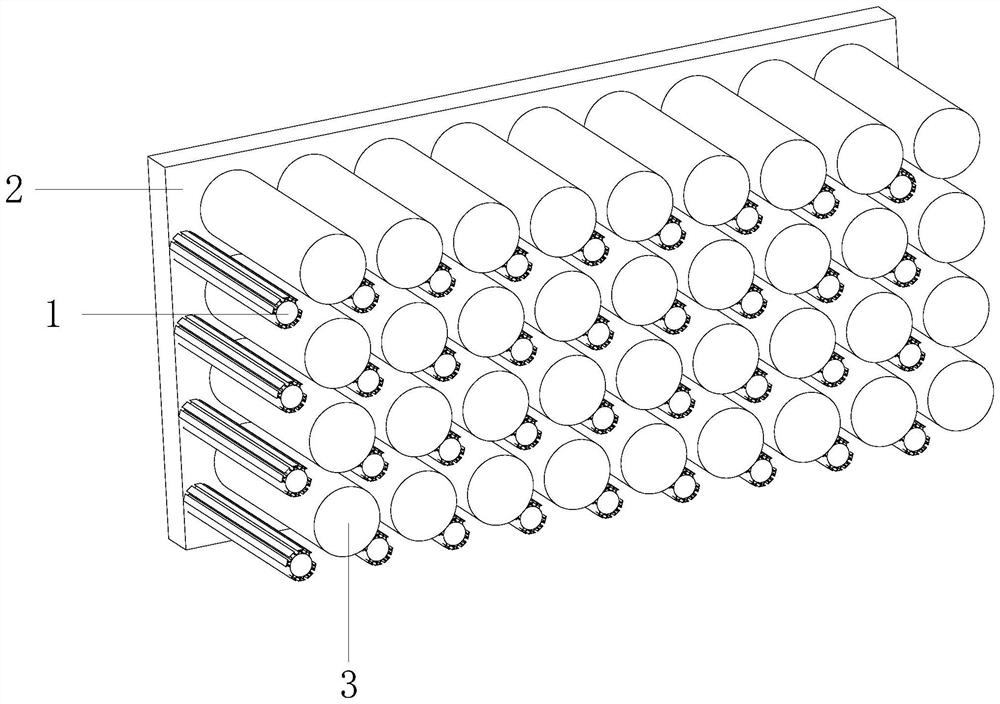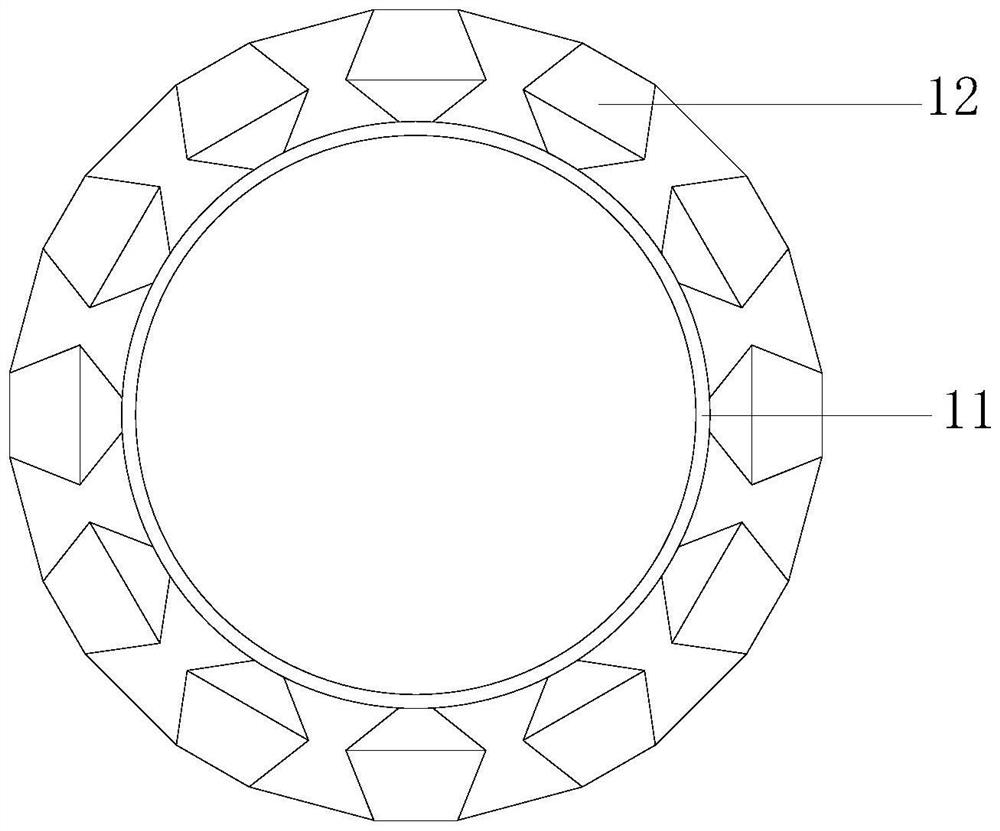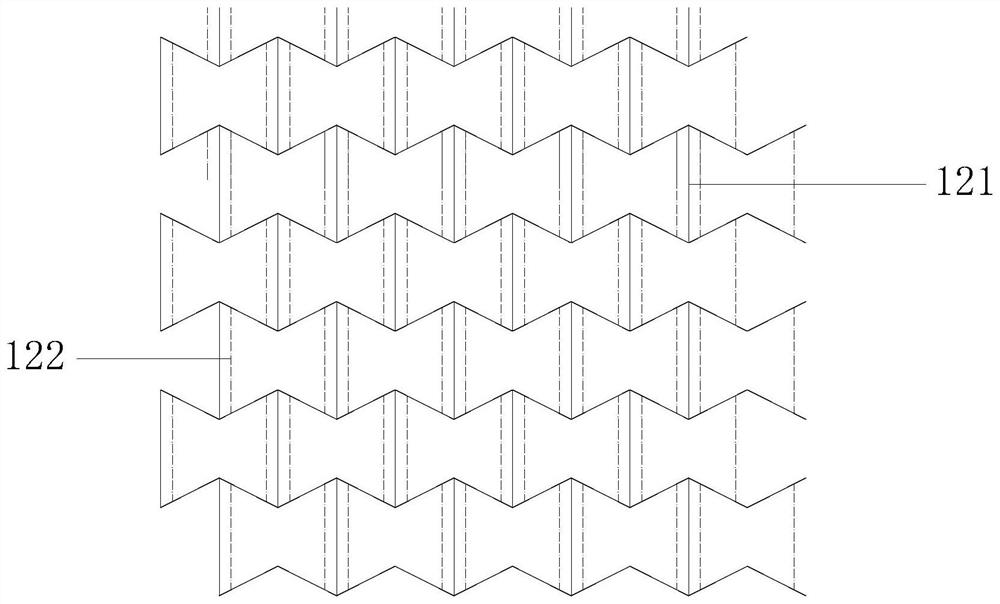Self-adaptive cooling variable battery cell bracket
A variable and self-adaptive technology, applied in circuits, electrical components, secondary batteries, etc., can solve problems such as shortened battery life, and achieve the effect of lowering the temperature and uniform temperature distribution of the battery
- Summary
- Abstract
- Description
- Claims
- Application Information
AI Technical Summary
Problems solved by technology
Method used
Image
Examples
Embodiment 1
[0032] see Figure 1 to Figure 3 , an adaptive cooling variable cell support provided by this embodiment includes:
[0033] The cell support 1 is used for fixed installation and protection of the cells. The cell support 1 is designed with a negative Poisson's ratio structure. The cell support 1 includes a support structure 11 and a cell structure 12. A first structural wall 121 is used on the outside of the support structure 11, and a first structural wall 121 is used on the outside of the cell structure 12, and a second structural wall 122 is disposed on the inside of the first structural wall 121. The thermal expansion coefficient of the material used for the first structural wall 121 is much larger than that of the second structural wall 121 The thermal expansion coefficient of the material used for the structural wall 122;
[0034] Bracket plate 2, used to fix and install the cell bracket 1;
[0035] The battery cells 3 are used to provide electric energy. The battery ce...
Embodiment 2
[0041] An adaptive cooling variable cell support provided in this embodiment includes:
[0042] The cell support 1 is used for fixed installation and protection of the cells. The cell support 1 is designed with a negative Poisson's ratio structure. The cell support 1 includes a support structure 11 and a cell structure 12. A first structural wall 121 is used on the outside of the support structure 11, and a first structural wall 121 is used on the outside of the cell structure 12, and a second structural wall 122 is disposed on the inside of the first structural wall 121. The thermal expansion coefficient of the material used for the first structural wall 121 is much larger than that of the second structural wall 121 The thermal expansion coefficient of the material used for the structural wall 122;
[0043] Bracket plate 2, used to fix and install the cell bracket 1;
[0044] The battery cells 3 are used to provide electric energy. The battery cells 3 are arranged between th...
Embodiment 3
[0050] An adaptive cooling variable cell support provided in this embodiment includes:
[0051] The cell support 1 is used for fixed installation and protection of the cells. The cell support 1 is designed with a negative Poisson's ratio structure. The cell support 1 includes a support structure 11 and a cell structure 12. A first structural wall 121 is used on the outside of the support structure 11, and a first structural wall 121 is used on the outside of the cell structure 12, and a second structural wall 122 is disposed on the inside of the first structural wall 121. The thermal expansion coefficient of the material used for the first structural wall 121 is much larger than that of the second structural wall 121 The thermal expansion coefficient of the material used for the structural wall 122;
[0052] Bracket plate 2, used to fix and install the cell bracket 1;
[0053] The battery cells 3 are used to provide electric energy. The battery cells 3 are arranged between th...
PUM
 Login to View More
Login to View More Abstract
Description
Claims
Application Information
 Login to View More
Login to View More - R&D
- Intellectual Property
- Life Sciences
- Materials
- Tech Scout
- Unparalleled Data Quality
- Higher Quality Content
- 60% Fewer Hallucinations
Browse by: Latest US Patents, China's latest patents, Technical Efficacy Thesaurus, Application Domain, Technology Topic, Popular Technical Reports.
© 2025 PatSnap. All rights reserved.Legal|Privacy policy|Modern Slavery Act Transparency Statement|Sitemap|About US| Contact US: help@patsnap.com



